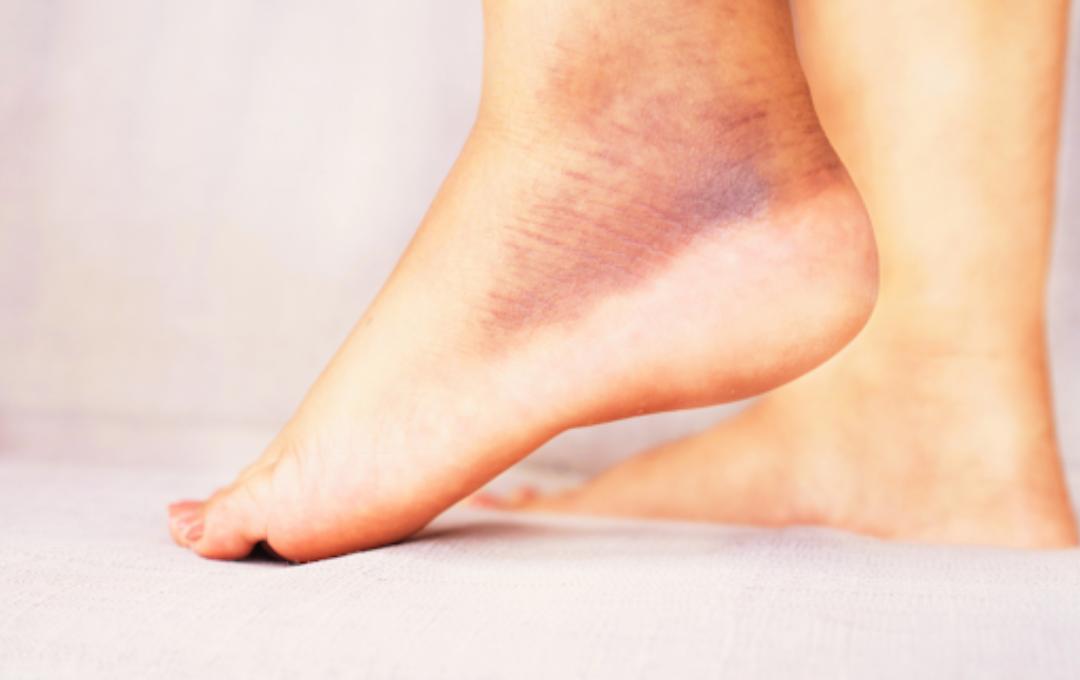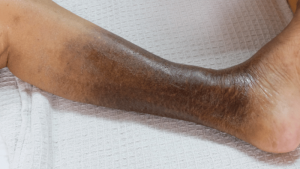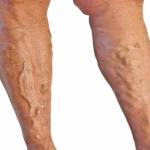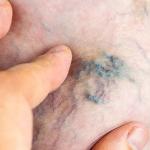
Have you noticed the skin on your lower legs gradually becoming darker or brown? Do your legs feel achy or look swollen? If you answered ‘yes’ to any of these questions, you may have hemosiderin staining.
Hemosiderin staining may indicate an underlying health issue, the most common being vein disease. Treating the underlying vein disease can help improve leg circulation, reduce skin discoloration, and prevent unwanted complications. USA Vein Clinics can diagnose hemosiderin staining and create a personalized treatment plan for effective symptom relief. Scheduling is easy with our online scheduling tool—make an appointment with a vein specialist today.
Schedule Your Consultation Online
What is Hemosiderin Staining?
Hemosiderin staining occurs when iron-rich protein accumulates underneath the skin. This iron, a by-product of broken-down blood cells, often results from varicose veins. The accumulation causes skin darkening, which might be less noticeable in individuals with darker skin tones. Importantly, hemosiderin staining can also be accompanied by other symptoms such as aches, pains, and feelings of heaviness in the legs.
Hemosiderin staining often results from chronic venous insufficiency (CVI), where blood pools in the legs due to malfunctioning vein valves. This leads to iron leaking through vein walls and depositing in the skin. While hemosiderin staining is not immediately dangerous, it signals ongoing circulation issues that can lead to future complications if left untreated.
What Does Hemosiderin Staining Look Like?
Hemosiderin staining appears as a brown or rust color on the skin, typically around the lower legs and ankles, resembling a bruise. On darker skin tones, this discoloration may be less noticeable. However, other symptoms, such as dry, hardened, or itchy skin, can still indicate underlying vein disease.
Causes of Hemosiderin Staining on the Legs
Common underlying conditions that can lead to hemosiderin hyperpigmentation include varicose veins, blood clots, and leg trauma. Let’s explore the common underlying conditions, such as varicose veins, blood clots, and leg trauma, that can contribute to hemosiderin hyperpigmentation.
Chronic Venous Insufficiency (CVI)
In healthy veins, blood travels upward towards the heart aided by one-way valves. Chronic venous insufficiency (CVI), or vein disease, occurs when these valves no longer function, causing the blood to pool in the legs. Blood pooling can damage veins, causing them to leak into the skin. This leakage results in hemosiderin staining.
Varicose Veins
Varicose veins are a symptom of chronic venous insufficiency. These veins can look twisted and bulge from underneath the skin. In addition to their appearance, varicose veins can cause leg pain, swelling, and discoloration like hemosiderin staining.
Deep Vein Thrombosis (DVT)
DVT is a blood clot that forms in the leg’s deep veins, which can be life-threatening if the clot breaks loose and travels to the lungs. Blood clots obstruct normal blood flow in the veins, increasing pressure on the area. This slowed traffic causes blood to flow out of the vein and into the surrounding tissue, resulting in hemosiderin staining.
Leg Trauma
A recent or chronic injury such as an ankle sprain, bruising, or a bone break can damage the surrounding blood vessels, leading to hemosiderin staining.
What Are the Symptoms of Hemosiderin Staining?
While no two individuals experience hemosiderin staining the exact same way, here are some common signs of hemosiderin staining to look out for:
Skin discoloration
Rust or brown patches may appear on the legs, particularly the lower legs and ankles, and often resemble a bruise. The visibility of this discoloration can vary based on skin tone.
Skin hardening
Iron-rich deposits from broken-down red blood cells may also harden the surrounding skin, causing it to feel firm or leathery.
Itchiness or skin irritation
The buildup of hemosiderin can trigger an inflammatory response, leading to dry, itchy, or irritated skin. The compromised circulation and skin barrier can also make the area more sensitive, contributing to discomfort and itchiness.
Swelling
Swelling is primarily due to chronic venous insufficiency (CVI), where poor blood flow causes fluid to accumulate in the legs. The increased venous pressure prevents effective drainage of fluid from the tissues, leading to swelling, particularly around the ankles and lower legs.
If you have these symptoms and are unsure if it’s caused by vein disease, USA Vein Clinics has an online symptom quiz to help determine whether you need to see a vein specialist.
Is Hemosiderin Staining Dangerous?
While hemosiderin staining itself is not dangerous, it signals underlying vein issues that, if left untreated, can lead to serious complications. Treating hemosiderin staining early is a proactive measure that can help you avoid harder-to-manage symptoms or more serious conditions, including:
- Venous ulcers: Open sores on the legs that are difficult to heal. These ulcers can cause pain and limit movement due to their location. Open ulcers also increase vulnerability to infections.
- Infections: Changes in the skin caused by hemosiderin staining can lead to complications like cellulitis, a bacterial infection of the skin and surrounding tissue. If untreated, cellulitis may progress to osteomyelitis, a bone infection usually found in the lower legs and ankles.
- Chronic pain: Untreated venous ulcers or infections can lead to further tissue damage and scarring, causing pain in the lower legs. This pain may impair mobility and movement, leading to hindered daily activities.
Hemosiderin Staining Treatment Options
Hemosiderin staining may be permanent if a patient delays treatment of the underlying condition. Early detection and treatment can help prevent the staining from becoming more prominent. Skin-lightening creams may promise a reduction of discoloration, but the FDA has declared them unsafe for over-the-counter use. The best action is to discuss hemosiderin staining with a vein specialist. They can determine if vein disease is causing it and offer minimally invasive treatments to reduce painful symptoms.
USA Vein Clinics offers these treatments that can be personalized to your situation. These treatments are FDA-approved and have fewer risks than surgical methods. Patients can benefit from quick and convenient care with short recovery times. Additionally, patients will notice significant pain reduction. Those who developed hemosiderin staining may notice a reduction in appearance over time.
When to See a Vein Specialist
If you notice discoloration, swelling, or aching in the legs, consult a vein specialist for a diagnosis and effective care.
Early diagnosis of hemosiderin staining and underlying vein conditions can provide more treatment options and help prevent complications. A vein specialist can offer personalized treatment to manage symptoms and maintain your leg health.
Schedule a consultation with a vein specialist today. Use our online scheduling tool, or call 888.768.3467 to book your appointment. With locations nationwide and partnerships with most insurance providers, USA Vein Clinics makes vein care accessible and convenient. Enter your zip code below to find a vein clinic near you.
FAQs
How Long Does Hemosiderin Staining Last?
Hemosiderin staining can linger for months or even years as the pigment gradually accumulates in the skin. However, treating its underlying cause can help discoloration fade over time.
Can Hemosiderin Staining Be Removed?
Removing hemosiderin staining may not always be possible, but minimally invasive treatments can significantly reduce its appearance and prevent progression. Treating the underlying cause of hemosiderin staining can help lighten discoloration and improve mobility and overall health.
What causes brown discoloration on feet?
Brown discoloration on the feet can have several causes, including hemosiderin staining, fungal infections, sun damage, and certain medications. If you are concerned about brown discoloration on your feet, you should consult a vein specialist to determine if vein disease is causing brown discoloration on the legs and feet.
Schedule An Appointment with a Vein Specialist
Medically Reviewed By:
Dr. Yan Katsnelson is a philanthropist, business owner, and highly skilled cardiac surgeon. He is the Founder and CEO of USA Vein Clinics, which is part of USA Clinics Group, the parent company of USA Fibroid Centers, USA Vascular Centers, and USA Oncology Centers, with more than 100 facilities nationwide. Dr. Yan has established himself as a strong advocate for accessibility and affordability of the most advanced medical care close to home. His mission is to create a positive experience for each patient with compassionate, personalized, and expert care.









